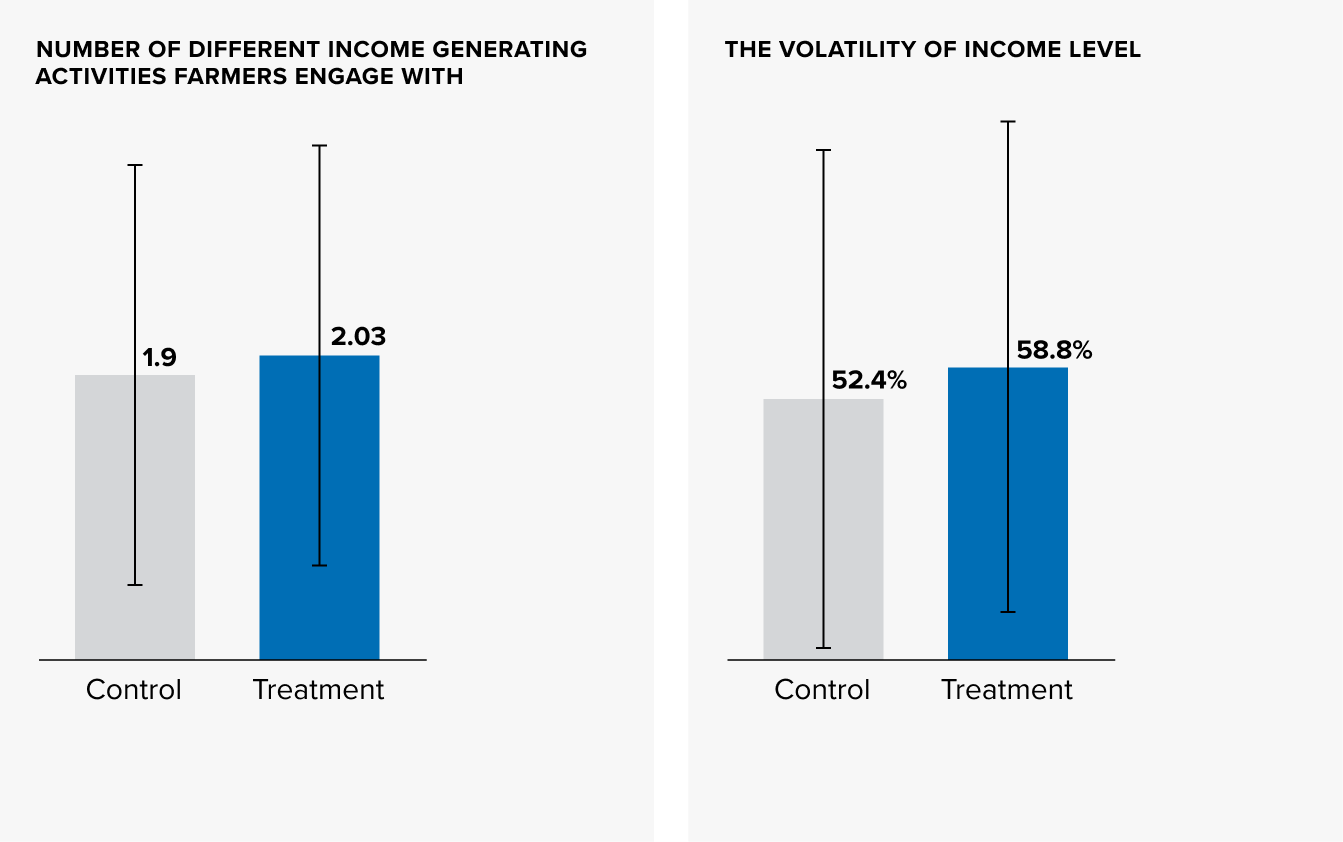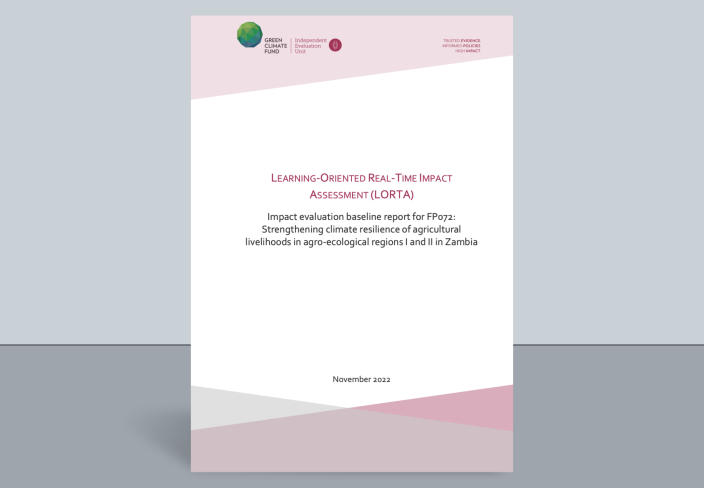Zambia: Enhancing farmers’ resilience through livelihood diversification
Published on 08 May 2023
Overview
Improving food security, income generation and access to markets for vulnerable farmers is crucial to sustain the agriculture activity in Zambia - the backbone of its rural economy, with 60 percent of livelihoods depending on it.
Diversifying livelihoods for climate risk
Zambian’s smallholder farmers face considerable hardships in adapting to the changing climate given their limited crop diversity, access to productive assets and market opportunities¹. Evidence suggests that on-farm livelihood diversification (e.g., planting a crop or variety mix, or combining crop and livestock operations) can be a successful practice to avert climate-related risk and increase food security and income streams in the country². However, given that diversification options are very context-specific, it is critical to assess how the available mix of alternative strategies can contribute to an effective adaptation response of local farmers.
Beehives’ and Goats’ provision
Aiming at strengthening the capacity of smallholder farmers to plan for climate risks, improving food security and income generation, the “Strengthening climate resilience of agricultural livelihoods in agro-ecological regions I and II” project (SCRALA) promotes climate-resilient farming, different diversification practices and access to markets for the most vulnerable farmers in the country. Financed by the GCF, and implemented by the Zambian Ministry of Agriculture with UNDP’s support, the project takes a value chain approach, addressing barriers to climate-resilient agriculture across key stages of the value chain – planning, inputs, production, and post-production. The project expects to contribute to achieving targets under the Sustainable Development Goals (SDGs) 1 - ‘No poverty’, 2 - ‘Zero Hunger’ and 13 - ‘Climate Action’. Data collections efforts were done to measure specifically the effects of trainings and distribution of alternative livelihoods - beehives and goats.
From Theory to Reality: How project’s inputs and activities are expected to generate impact
What the data tells us
A detailed and extensive data collection for both beneficiary and non-beneficiary households was conducted in 2020, covering a total of 2,508 households (1,218 beneficiary and 1,290 non-beneficiary) from 15 districts in 5 provinces. Focus was given on collecting ground information on household characteristics, food security, food consumption and expenditure shares, coping strategies, and measurements of income and agricultural yields.
Data shows that beneficiary households appear to engage in a larger number of income generating activities. This finding might reflect the early provision of the inputs: many households (around 60 per cent) reported to have received at least one goat or beehive before the baseline data was collected. The differences observed between groups can be interpreted as a snapshot of the short-term impacts of the projects’ interventions, as beehives and goats appear to impact wealth quickly³.
However, beneficiary households also experience a higher exposure to economic (e.g. food price changes) and environmental shocks (e.g. droughts) and higher volatility of income levels. Also, beneficiary households experience higher levels of food insecurity and a lower diversity of food consumption, but at the same time they also tend to spend a higher share of their income on food. Overall, the results of the on-the-ground assessment illustrate that the project's beneficiaries are well targeted.

Note: The designations employed and the presentation of material on this map do not imply the expression of any opinion whatsoever on the part of the Secretariat of the United Nations or UNDP concerning the legal status of any country, territory, city or area or its authorities, or concerning the delimitation of its frontiers or boundaries.
| Variables | Entire sample | Beneficiary (T) | Non-beneficiary (C) | T-C | p value |
|---|---|---|---|---|---|
Livelihood diversification | |||||
| Farmers with agriculture as the only source of income | 10,37% (30,49) | 8,54% (27,96) | 12,09% (32,62) | -3,55 | 0,004 |
| Number of different income generating activities farmers engage with | 1,97 (1,40) | 2,03 (1,40) | 1,90 (1,40) | 0.13* | 0,020 |
| Number of different crops planted | 2,20 (1,14) | 2,19 (1,12) | 2,21 (1,16) | -0,02 | 0,733 |
Income stability | |||||
| The volatility of income level | 55,50% (49,71) | 58,78% (49,24) | 52,40% (49,96) | 6.38** | 0,001 |
| The average level of yields (Maize) | 1520,78 (3187,07) | 1494,17 (3440,43) | 1546,76 (2919,86) | -52,59 | 0,687 |
Food security | |||||
| Food consumption score | 43,3 (21,1) | 42,4 (21,2) | 44,2 (21,0) | - 1.77* | 0,036 |
| Acceptable household dietary diversity (%) | 47,0% (50,0) | 45,0% (50,0) | 49,0% (50,0) | -0,3 | 0,108 |
| Food expenditure shares | 49,98% (21,73) | 51,24% (21,90) | 48,8% (21,51) | 2.43** | 0,005 |
| Coping strategies index | 5,52 (4,64) | 5,51 (4,56) | 5,53 (4,71) | -0,02 | 0,923 |
Economic shocks | |||||
| Sharp food price increase | 53.35% | 55.50% | 51.32% | 4.65%* | 0.0201 |
| Increase price of agricultural/livestock input | 32.74% | 32.27% | 33.18% | -0.14% | 0.9418 |
| Death of livestock (cattle, donkeys, or goats) due to disease or lack of food or water (poverty deaths) | 37.88% | 44.42% | 31.71% | 12.78%*** | <0.0001 |
| Drought | 49.36% | 55.09% | 43.95% | 11.10%*** | <0.0001 |
Note: * p < 0.05, ** p < 0.01, *** p<0.001
What's next
New rounds of data collection (expected for the last quarter of 2025) will provide novel evidence on to the level of engagement of beneficiaries in income generating activities, levels of food security and diversification of livelihoods. The observed differences in income stability and nutrition status between groups of farmers are expected to reduce as project’s participants enhance their resilience within a short period of time.
Also, given that the selection of beneficiaries is at the individual level, non-beneficiary farmers located in the same village as beneficiary farmers could also indirectly benefit from the project’s activities. Tailored data collection will allow to assess whether improvements in income by an individual beneficiary household can be translated into a widespread increasing economic activity within the villages.
References
[1] Makondo et al., 2014
[2] Arslan et al., 2016
[3] Freeman et al., 2008
Intervention
The SCRALA project (2018 - 2025) aims at strengthening the resilience to climate change risks of vulnerable smallholder farmers in the country’s agroecological regions I and II. The project is making targeted interventions to capitalize on opportunities to strengthen and promote viable climate-resilient value chains relating to smallholder agriculture in the target regions, specifically targeting value chains that are gender sensitive and provide viable economic opportunities for women. This includes three interrelated outputs: i) strengthening capacity of farmers to plan for climate risk; ii) strengthening resilient agricultural production and diversification practices (for both food security and income generation); and iii) strengthening farmers’ access to markets and commercialization of introduced resilient agricultural commodities.
A key activity of the project related to the strengthen farmer field schools, which will serve as demonstration sites for training sessions on sustainable agricultural practices. At these centres, training will be first delivered to the community’s leading farmers who will set the example for others to follow. Each of the camps will receive training and inputs to adopt alternative livelihoods, which includes the distribution of 1,520 beehives and 14,000 goats that expects to benefit up to 50,000 households. The approach of the evaluation was chosen specifically to assess the impact of the beehive and goat provision.
Project Overview
Steps to assess impact
- Inception (plan, design and team set up)
- Develop & pilot a survey instrument
- Conduct a baseline survey & analysis
- Programme/Project implementation
- Conduct follow-up survey & analysis
- Estimation of impact / final report writing
- Dissemination of findings/evidence
Status
Ongoing
Start Date
October 2018
End Date
last quarter of 2025
survey firm
Institut Publique de Sondage d'Opinion Secteur (IPSOS)
Technical partners
UNDP
Independent Evaluation Unit/Green Climate Fund (IEU/GCF)
Center for Evaluation and Development (C4ED)
Approaches to assess the impact
The baseline data collection covered 2,508 households (1,218 treatment and 1,290 control). Indicators related to income, crop productivity, food security, access to weather information among others. The initial design to assess impact was a Randomized Control Trial through a public lottery. However, the early distribution of alternative livelihood inputs to beneficiaries (before baseline data collection) and the lack of control group data entails amendment in the evaluation strategy. The evidence provided by the baseline data highlights significant differences between treatment and control households, and many results indicate that the treatment group is wealthier than the control group. The feasibility of a Randomized Control Trial hinges on receiving or collecting information on the lottery losers. Feasible alternatives are quasi-experimental designs such as Difference-in-Difference and Propensity Score Matching. Endline data is expected to be collected in 2025.









